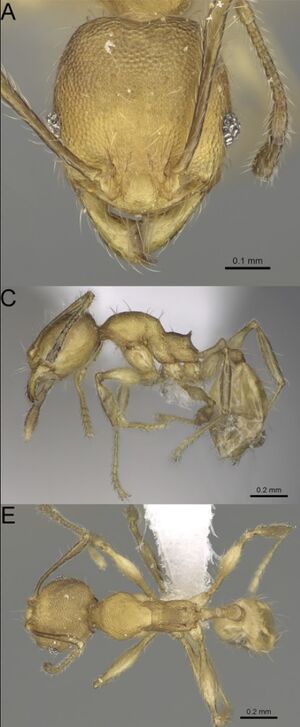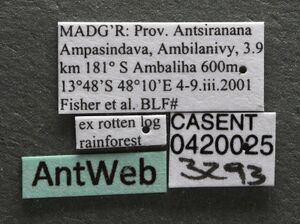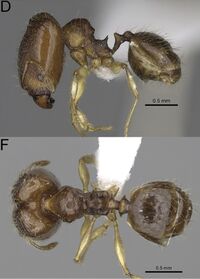Pheidole fitarata
| Pheidole fitarata | |
|---|---|

| |
| Scientific classification | |
| Kingdom: | Animalia |
| Phylum: | Arthropoda |
| Class: | Insecta |
| Order: | Hymenoptera |
| Family: | Formicidae |
| Subfamily: | Myrmicinae |
| Tribe: | Attini |
| Genus: | Pheidole |
| Species group: | makaensis |
| Species: | P. fitarata |
| Binomial name | |
| Pheidole fitarata Salata & Fisher, 2020 | |
The species was collected between 10–780 m in elevation, in rainforest, in tropical dry forest, and in littoral rainforest. Nests were located rotten logs.
Identification
Salata and Fisher (2020) - A member of the Pheidole makaensis species group. Major. Head in full-face view elongated; sides of the head with moderately dense, long, erect pilosity; occipital lobes smooth to indistinctly foveolate, with thick, sparse, short, transverse, and sometimes arcuate rugae; inner hypostomal teeth distinct, high, closely spaced, triangular, with rounded apex directed inward; outer hypostomal teeth thinner than inner hypostomal teeth and approximately the same height, triangular. Minor:. Head foveolate, genae smooth; scape, when laid back, surpassing the posterior head margin by two-fifths of its length; promesonotum low, convex, short, with posterior declivity relatively convex; mesosoma foveolate, katepisternum with smooth notch; propodeal spines short, triangular.
Pheidole fitarata is most similar to Pheidole rugofitarata and Pheidole avaratra. Major workers. Pheidole fitarata differs from P. rugofitarata in less distinct and interrupted longitudinal rugae on frons and antennal scrobes, lack of connection between rugae on frons and occipital lobes, smooth genae, and never lobe-like outer hypostomal teeth; from P. avaratra in presence of longitudinal, thick, and interrupted rugae on frons and antennal scrobes, frons with rugae weakening posteriorly and never connected with rugae on the occipital lobes, genae smooth, and smaller and directed inward inner hypostomal teeth. Minor workers. Pheidole fitarata differs from P. avaratra in longer and lower promesonotum and katepisternum with smooth notch.
Keys including this Species
Distribution
Distribution based on Regional Taxon Lists
Malagasy Region: Madagascar (type locality).
Distribution based on AntMaps
Distribution based on AntWeb specimens
Check data from AntWeb
Countries Occupied
| Number of countries occupied by this species based on AntWiki Regional Taxon Lists. In general, fewer countries occupied indicates a narrower range, while more countries indicates a more widespread species. |

|
Biology
Castes
Worker
Minor

| |
| . | |
Images from AntWeb
 
| |
| Worker. Specimen code casent0420025. Photographer Michele Esposito, uploaded by California Academy of Sciences. | Owned by CAS, San Francisco, CA, USA. |
Major
Images from AntWeb

| |
| Worker (major/soldier). Specimen code casent0420028. Photographer Michele Esposito, uploaded by California Academy of Sciences. | Owned by CAS, San Francisco, CA, USA. |
Nomenclature
The following information is derived from Barry Bolton's Online Catalogue of the Ants of the World.
- fitarata. Pheidole fitarata Salata & Fisher, 2020: 124, figs. 46A–F, 84S, 86S (w.) MADAGASCAR.
Unless otherwise noted the text for the remainder of this section is reported from the publication that includes the original description.
Description
Worker
Major (N = 10): HL: 1.13-1.43 (1.29); HW: 0.91-1.12 (1.07); SL: 0.43-0.53 (0.49); EL: 0.12-0.17 (0.14); WL: 0.79-1.02 (0.92); PSL: 0.16-0.21 (0.18); MTL: 0.51-0.59 (0.55); PNW: 0.45-0.64 (0.56); PTW: 0.11-0.19 (0.16); PPW: 0.29-0.47 (0.41); CI: 77.9-88.4 (82.7); SI: 43.5-49.0 (46.5); PSLI: 12.7-15.3 (14.0); PPI: 34.8-42.9 (38.2); PNI: 49.1-56.7 (52.8); MTI: 48.4 -56.1 (52.0). Head. In full-face view longitudinal, longer than wide, anterior of eyes straight, posterior of eyes slightly convex, occipital margin of lobes straight, inclining toward centre. In lateral view sub-rectangular; ventral and dorsal faces finely convex; dorsal face finely depressed posteriorly, forming indistinct transverse depression between frons and occipital lobes; inner hypostomal teeth visible. Sides of the head with moderately dense, long, erect pilosity; whole head with dense, moderately long, suberect to erect pilosity. Antennal scrobes indistinct and not delimited by carinulae; scrobe surface shiny, foveolate, with thick, longitudinal, short, and interrupted rugae. Occipital lobes shiny, smooth to indistinctly foveolate, with thick, sparse, short, transverse, and sometimes arcuate rugae; frons with moderately dense, thick, longitudinal and interrupted rugae, interspaces smooth and indistinctly foveolate on the posterior part, rugae weakening posteriorly and never connected with rugae on the occipital lobes; genae shiny and smooth; malar area with thick, longitudinal, moderately sparse rugae, interspaces smooth. Centre of clypeus shiny and smooth, lateral sides with longitudinal rugae; median notch present, wide, and shallow; median longitudinal carina absent; lateral longitudinal carinae absent. Scape, when laid back, not reaching the mid-length of head; pilosity suberect to erect. Inner hypostomal teeth distinct, high, closely spaced, triangular, with rounded apex directed inward; outer hypostomal teeth thinner than inner hypostomal teeth and approximately the same height, triangular. Mesosoma. In lateral view, promesonotum relatively low and arched, posterior mesonotum relatively steep, with tubercle-like projections; promesonotal groove absent; metanotal groove indistinct; propodeal spines moderately long, triangular, with sharp apex and wide base; humeral area laterally weakly produced. Surface finely foveolate, dorsal surface of promesonotum with fading sculpture and sometimes with smooth notch; katepisternum with smooth notch; lower half of lateral sides of propodeum with additional longitudinal rugae. Pilosity sparse, very long, and erect. Petiole. Shiny; peduncle moderately long, finely foveolate, with indistinct horizontal lobes on its basal part; node smooth, relatively high, triangular, with rounded apex, in rear view node slightly convex; pilosity moderately sparse and erect. Postpetiole. Shiny and finely shagreened, dorsum with fading sculpture; in dorsal view sides with moderately short, acute, and triangular projections; pilosity long to moderately long, and erect. Petiole. Shiny and finely shagreened; pilosity moderately dense, long, and erect. Colour. Bright brown to brown; legs, lower frons, malar area and lower parts of lateral sides of mesosoma yellowish brown.
Unless otherwise noted above, the following characters occur in this species, and the majority of Pheidole majors of Madagascar described by Salata and Fisher 2020a. Antennal sockets shallow; frontal lobes absent; head in full-face view with distinct median concavity; antenna 12-segmented, with 3-segmented club; masticatory margin of mandible with large, stout apical and preapical teeth, followed by a long diastema and then a short and crenulate tooth just before the rounded basal angle; outer surface of mandible mostly smooth and shining, sometimes with weak and sparse foveolae; antennal scrobes present; promesonotum strongly convex, well above the level of propodeum; postpetiole short with slightly convex dorsum; ventral process absent.
Minor (N = 6): HL: 0.45-0.47 (0.46); HW: 0.39-0.41 (0.4); SL: 0.44-0.46 (0.45); EL: 0.07-0.1 (0.08); WL: 0.52-0.56 (0.55); PSL: 0.08-0.09 (0.08); MTL: 0.33-0.36 (0.35); PNW: 0.26-0.28 (0.27); PTW: 0.06-0.06 (0.06); PPW: 0.09-0.1 (0.1); CI: 85.9-89.5 (87.7); SI: 111.0-113.6 (111.6); PSLI: 17.3-20.4 (18.5); PPI: 61.0-65.2 (62.5); PNI: 66.4-68.8 (67.8); MTI: 82.8-89.4 (86.7). Head. Occipital margin straight or indistinctly concave; occipital carina absent. Pilosity moderately dense, long, suberect. Head shiny, foveolate; genae smooth. Clypeus smooth or finely foveolate; median longitudinal carina absent; two lateral longitudinal carinae absent. Scape, when laid back, surpassing the posterior head margin by two-fifths of its length; pilosity suberect to erect. Mesosoma. In lateral view, promesonotum low, convex, short, with posterior declivity relatively convex; promesonotal groove absent; metanotal groove indistinct; propodeal spines short, triangular, with acute apex. Sculpture foveolate; katepisternum with smooth notch. Pilosity sparse, long, and erect. Petiole. Peduncle short and thin with ventral face slightly convex; with few short, erect setae. Postpetiole. Short, low, and convex; sometimes with few short, erect setae. Petiole. With moderately sparse, erect pilosity. Colour. Yellow.
Unless otherwise noted above, the following characters occur in this species, and the majority of Pheidole minors of Madagascar described by Salata and Fisher 2020a. Antennal sockets shallow; frontal lobes absent; head in full-face view oval, posterior and anterior of eyes convex; antenna 12-segmented, with 3-segmented club; humeral area not developed; clypeus smooth and shiny; its anterior margin regularly convex; promesonotum well above the level of propodeum; petiole smooth; petiole with node moderately low, triangular and small postpetiole smooth; gaster smooth and shiny.
Type Material
Holotype. Madagascar. 1 major worker; Antsiranana; Ampasindava, Forêt d’Ambilanivy, 3.9 km 181°S Ambaliha; -13.79861, 48.16167; alt. 600 m; 4 Mar 2001; Fisher et al. leg.; BLF03293, CASENT0420028 (California Academy of Sciences). Paratypes. Madagascar. 4w., 1s.; same data as for holotype; CASENT0420024-CASENT0420027, CASENT0872215-CASENT0872217 (CASC).
Etymology
Malagasy for mirror, in reference to smooth and shiny genae of major workers.
